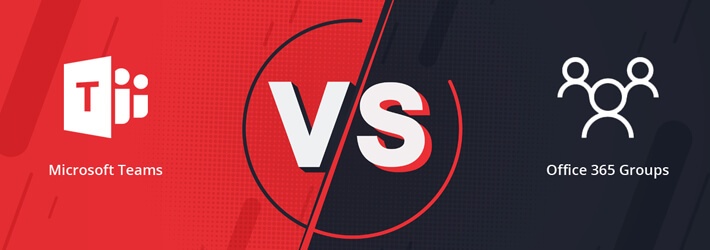
Before we start, I would like to point out that the title “Office 365 Groups vs Teams” is slightly misleading. The reason is that Office 365 groups and Microsoft Teams are not in competition with each other. In fact, they can actually complement each other, providing we have a basic understanding of how they work together. It’s worth remembering that, whenever a new Team is created, an associated Office 365 group is also created.
What is Office 365?
Let’s recap. Office 365 is the cloud-based version of the Microsoft Office productivity suite, which includes all of the same core applications, such as Word, Excel, PowerPoint, and Outlook. Office 365 includes additional applications such as OneNote, Publisher, Planner, OneDrive, Exchange, SharePoint, Access, Skype, Yammer, and of course, Teams.
What is MS Teams?
Microsoft Teams is a communication and collaboration platform that provides chat, video conferencing, file storage, third-party apps, and more. As mentioned above, when a new Team is created, and new Office 365 group is automatically created, along with a SharePoint document library and a OneNote notebook.
What is an Office 365 Group?
An Office 365 group is an object stored in Azure Active Directory, which is created by a Microsoft 365 admin. Admins can add members to the group, thus giving them access to its resources.
Office 365 Groups vs MS Teams: How Do They Differ?
Firstly, the interfaces are quite different. An Office 365 group has a similar interface to Outlook, whereas the MS Teams interface is arguably more modern. Secondly, Microsoft Teams has certain features that are not available to an Office 365 group. For example, Teams facilitates voice and video calling and also has a Desktop version.
Naturally, Teams does a better job when it comes to communication and collaboration since that’s what it was designed for. Unfortunately, Office 365 groups and MS Teams don’t integrate seamlessly. To illustrate my point, let’s consider the following two scenarios:
Creating a New Team and Connecting it to an Existing Group
If you are the admin of an existing group, when creating a new Team, you can connect it to an existing Office 365 group. However, there are some inconsistencies that you should be aware of.
Firstly, from within Teams, you cannot view the file repositories associated with the group unless you add a SharePoint tab, which means you will have two separate tabs open for viewing files, which is obviously not ideal.
Secondly, you will not be able to see any OneNote content associated with the group, only the OneNote content created for each Teams channel. Likewise, you will not be able to view any existing Planner tasks from the group, and any Planner tasks created in Teams will not be available in the Office 365 group or Planner.
Creating a New Team and Not Connecting it to an Existing group
If you create a new Team but choose not to connect it to an existing Office 365 group, you may inadvertently create a group that has the same name and purpose as one that already exists, and there isn’t an easy way for Team members or admins to check if a Team or group with a similar name and purpose already exists.
Naturally, this can cause confusion and result in a disjointed and inconsistent workflow. For example, let’s say that you create a new Team called “Sales”, unaware that there is already a group with the same name and purpose. You start adding team members, content and conversations, only to then find out about the existing “Sales” group. Your only option would be to merge the two together.
While it is possible to migrate the members and the files from the new Team to the existing group, you won’t be able to migrate the conversations. For obvious reasons, this scenario should be avoided. Since a user’s Exchange Online mailbox can be accessed from within Teams, perhaps a better option would be to migrate the members and content (files, OneNote pages, Planner tasks, and buckets) from the existing group to the new Team.
At the end of the day, the decision to migrate the data from the existing group to the new Team, or the data from the new Team to the existing group, will depend on how much content there is, and how many members there are.
Of course, the ideal scenario would be to just use Teams for all activities that require communication and collaboration and avoid using groups altogether.
Conclusion
Either way, the point is that it’s not really a question of Office 365 groups vs Teams, as they can work well together, assuming you are aware of some of the inconsistencies beforehand. It’s also worth noting that many of these compatibility issues will likely be addressed in future releases of the Teams platform.
If you’d like to see how Lepide can help you maintain the security of your data when using MS Teams, schedule a demo with one of our engineers.